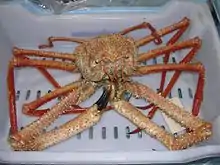Paromola cuvieri
Paromola cuvieri is a species of crab in the family Homolidae, the carrier crabs. It occurs in the eastern Atlantic Ocean and the Mediterranean Sea, from Angola to Norway, the Northern Isles and Iceland.[2][3][4] It is demersal, occurring at depths of 10–1,212 metres (33–3,976 ft), but it is primarily found deeper than 80 m (260 ft).[2] It prefers areas with mud and emerging rocks,[2] and has been observed in deep-water coral gardens and sponge aggregations.[5][6] It is locally common.[7]
| Paromola cuvieri | |
|---|---|
 | |
| Scientific classification | |
| Kingdom: | |
| Phylum: | |
| Subphylum: | |
| Class: | |
| Order: | |
| Infraorder: | |
| Family: | |
| Genus: | Paromola |
| Species: | P. cuvieri |
| Binomial name | |
| Paromola cuvieri (Risso, 1816) | |
| Synonyms [1] | |
| |
This reddish crab is sexually dimorphic; the males have larger claws and are overall larger than the females.[8] The carapace of the largest males can reach 21.5 cm (8.5 in),[2] while their claws can span 1.2 m (4 ft).[8] Like other members of the family, most P. cuvieri in their natural habitat carry an object, typically a living sessile invertebrate such as a sponge or deep-water coral, over the carapace in the small hindlegs.[5][6] This may be used as camouflage, but is also used actively in defense by positioning the object between the crab and a would-be attacker.[5] P. cuvieri is a scavenger of a wide range of animal matters,[2][5] and a predator of animals such as decapods, but only rarely takes small benthic species (glycerids, cumaceans and amphipods).[7]
References
- Fransen, Charles; Türkay, Michael (2011). "Paromola cuvieri (Risso, 1816)". World Register of Marine Species. Retrieved April 18, 2011.
- Palomares, M. L. D. and Pauly, D., eds. (2017). "Paromola cuvieri" in SeaLifeBase. June 2017 version.
- Gordon, Isabella (1956). "Paromola cuvieri (Risso), a crab new to the Orkneys, Shetlands and Norway". Nature. 178 (4543): 1184–1185. Bibcode:1956Natur.178.1184G. doi:10.1038/1781184a0.
- Lilliendahl, Kristján; Einarsson, Sólmundur T.; Pálsson, Jónbjörn (2005). "Tvær sjaldgæfar tegundir skjaldkrabba Decapoda við Ísland" [Two species of rare crabs, Paralomis spectabilis and Paromola cuvieri Crustacea, Decapoda, in Icelandic waters]. Natturufraedingurinn (in Icelandic and English). Hið íslenska náttúrufræðifélag. 733 (3–4): 89–94.
- Capezzuto, Francesca; Maiorano, Porzia; Panza, Michele; Indennidate, Antonella; Sion, Letizia; D'Onghia, Gianfranco (2011). "Occurrence and behaviour of Paromola cuvieri (Crustacea, Decapoda) in the Santa Maria di Leuca cold-water coral community (Mediterranean Sea)". Deep-Sea Research Part I: Oceanographic Research Papers. 53: 1–7. Bibcode:2012DSRI...59....1C. doi:10.1016/j.dsr.2011.10.006.
- Braga-Henriques; Carreiro-Silva; Tempera; Jakobsen; Jakobsen; Albuquerque; and Santos (2012). "Carrying behavior in the deep-sea crab Paromola cuvieri (Northeast Atlantic)". Marine Biodiversity. 42 (1): 37–46. doi:10.1007/s12526-011-0090-3.CS1 maint: uses authors parameter (link)
- Cartes, J.E. (1993). "Diets of deep-sea brachyuran crabs in the Western Mediterranean Sea". Marine Biology. 117 (3): 449–457. doi:10.1007/BF00349321.
- Thurston, Mike (1987). "Record breaking crab is not such a strange catch". New Scientist. 114 (1554): 24.